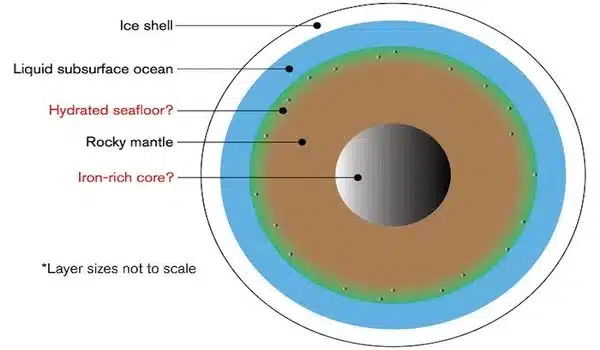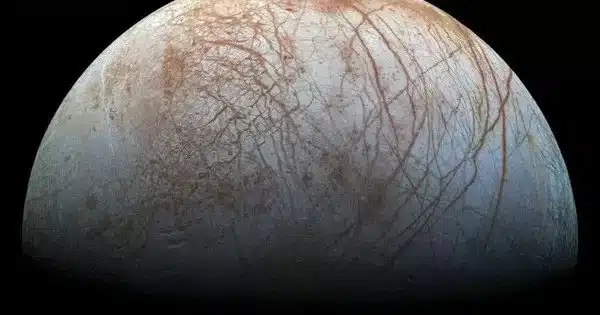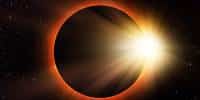Jupiter’s satellite Europa is regarded as one of the most fascinating bodies in our solar system due to the possibility of liquid water beneath its frozen surface. Europa’s ocean may have a metamorphic origin. While several scientists speculated on this, a research team found that if Europa was formed from hydrated rocks (rocks that contain hydrogen and oxygen), then enough of Europa’s interior should have become heated enough to discharge water directly from the hydrated rocks, forming the ocean and ice shell.
Europa, Jupiter’s moon, is slightly smaller than Earth’s Moon and is one of the most promising locations to look for alien life. Scientists are particularly interested in Europa in the Jovian system because of the strong evidence for nutrition, water, and energy that might potentially give a viable habitat for some type of life beyond Earth. Furthermore, Europa is thought to be composed of four layers (from surface to core): an ice shell, a saltwater ocean, a rocky mantle, and a metallic core.
Europa’s ocean, like Earth’s, meets the rocky seafloor, which may allow for favorable rock-water chemistry for life. Some scientists believe that volcanoes on the bottom could give more energy and nutrients to a possible biosphere.
Using computer code written by Trinh, ASU scientists Kevin Trinh, Carver Bierson, and Joe O’Rourke of the School of Earth and Space Exploration studied the ramifications of Europa forming with low initial temperatures. Their findings were just reported in the journal Science Advances.
The origin of Europa’s ocean is important because the moon’s potential to support life ultimately depends on the chemical ingredients and physical conditions during the ocean formation process.
Kevin Trinh
Hydrated rocks may be a key ingredient
Europa’s ocean may have a metamorphic origin. While several scientists speculated about this, Trinh and his colleagues show that if Europa was produced from hydrated rocks (rocks that contain hydrogen and oxygen), then enough of Europa’s interior should have become heated enough to discharge water directly from the hydrated rocks, forming the ocean and ice shell.
“The origin of Europa’s ocean is important because the moon’s potential to support life ultimately depends on the chemical ingredients and physical conditions during the ocean formation process,” said Kevin Trinh, graduate associate at Arizona State University’s School of Earth and Space Exploration.

Metallic core formation requires high temperatures
Many researchers researching Europa assumed that it developed with a metallic core during or shortly after accretion. This ASU study challenges that hypothesis, proposing that Europa’s metallic core may not have formed until billions of years after accretion (assuming it happened at all).
“We tend to think of most worlds in the solar system’s internal structure as being set shortly after they finish forming.” This work is extremely fascinating because it reframes Europa as a world whose interior has steadily evolved throughout its entire lifespan. This paves the way for future research into how these changes can be noticed in the Europa we see now,” said Carver Bierson, a postdoctoral research scholar at ASU’s School of Earth and Space Exploration.
The presence of a metallic core is inextricably linked to Europa’s internal heat, which may also cause seabed volcanism and contribute to a livable seafloor environment. It is unknown, however, whether Europa generated enough heat to develop such a core. Trinh’s code determines how heat is created and distributed throughout a moon by employing the same governing equations that many geodynamicists have used for decades. The team’s innovative result, on the other hand, comes from challenging the assumptions that are typical in Europa modeling: Europa, a small moon, could develop as a frigid mixture of ice, rock, and metal.
However, all of these processes require a hot interior. A small moon like Europa (~1% of Earth’s mass) may not have enough energy to trigger or sustain Earth-like processes – metallic core formation, seafloor volcanism, and ongoing rock-water geochemistry – which implies that Europa’s habitable potential is uncertain. The exact time at which Europa formed determines how much heat is available from the radioactive decay of a short-lived isotope of aluminum. Tidal heating (from gravitational interactions with Jupiter and other moons) also governs how quickly Europa’s interior separates into distinct layers.
Europa’s bottom may be cool and hydrated, with little (if any) seafloor volcanism. This study suggests that there may be minimal hydrothermal activity and seafloor volcanism on Europa, which might make it uninhabitable. Confident projections, on the other hand, necessitate more evidence.
















